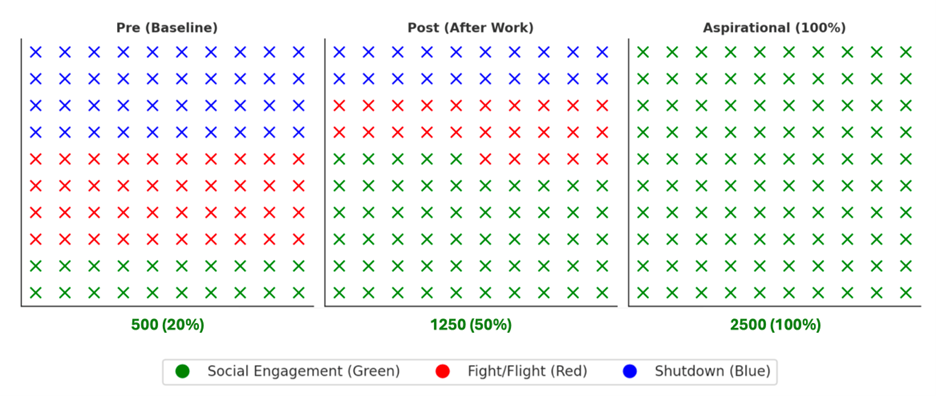We are discovering a shared truth: collaboration is necessary to improve population health outcomes, yet often difficult to reach. The personal desire for working together is strong and absolutely imperative. This is WHY we need to collaborate. What is missing are the enabling conditions that make collaboration possible and sustainable. When we focus on the HOW, we realize our potential for impact.

Neuroscience tells us what our hearts already know: we do not lead only with our minds. Through the lens of Polyvagal theory, we see that our nervous systems shape how we show up and interact with each other.

In our sessions, we bring together people across roles and perspectives—people with lived experience and families, clinicians, community leaders, and formal decision-makers. Everyone is invited to pause and reflect not only on their goals, but on their state of being:
● Where is my nervous system at?
● Where is my team at?
● Where is our organization and sector at?
● Where are the people and communities we serve?
These reflections are often eye-opening. Many recognize that, despite believing in collaboration, they are operating in a fight-or-flight state. Making this visible creates the possibility for a shift.
As Stephen M.R. Covey reminds us, “Change happens at the speed of trust.” We have seen that trust happens at the speed of the nervous system. When people shift from survival states into connection and social engagement, collaboration becomes possible. That is why attention to the nervous system is critical for system change—whether at the level of individuals, teams, organizations, partnerships, communities, or across provinces and the country.
Across thousands of people engaged in our sessions—clinicians, formal leaders, people with lived experience, families, community members—the findings are consistent:
● The majority identify as being in the “blue” (shut down) or “red”(stressed/over-activated) zones.
● A smaller proportion are in the “green” zone of social engagement, where calm ,connection, and creativity thrive.
● Nearly all aspire to be in the green.
At the start of sessions, baseline results often show only about 20% in the green zone. As the work unfolds together (learn, unlearn, grow, and create impact) that number rises toward 50–60% by the end. And whenever we ask, 100% of participants say they want to be in the green.
This reveals an important truth: the gap is not in aspiration. The will to collaborate exists. The challenge is creating the conditions for people and organizations to shift into green—and to remain there.
A system cannot advance integrated care if its leaders and teams are operating from survival mode. The nervous system of change makes this visible. It shows that trust-building is not an abstract leadership skill. It is embodied. It is relational. It is the correction.

This Insight to Action series is an invitation to learn together about how conditions for collaboration are built, how barriers can be named and addressed, and how commitments turn intent into action. It will also share insights from our work. Insights learned and practiced together.
1. From Insight to Action: Connection Is the Correction —Building the Conditions for Integrated Care
2. The Nervous System of Change —how neuroscience shows us that trust is embodied, not abstract. As Stephen M.R.Covey reminds us, “Change happens at the speed of trust.” And in our work, we see the next layer: trust happens at the speed of the nervous system — across individuals, teams, organizations, and sectors.
3. Elephants that need to be named and addressed to move forward — how unspoken barriers keep systems stuck. Naming them is the first step, but the real work is in identifying which are within our control to change, and then acting on them.
4. Advancing on the Collaboration Spectrum — what our data tells us about the gap between the collaboration leaders — as a person with lived experience, a clinician, a community worker or those in formal leadership roles across policy, research, organizational and sector leadership — want and the collaboration they experience. It also highlights where individuals see themselves in their own growth, where their teams and organizations are positioned, and where they aspire to be.
5. Individual and Collective Commitments —how personal and collective commitments translate insight into measurable action.

To learn more about our collective pursuit and see the upcoming blogs, explore 4CImpact.org or to get in touch with Jodeme (jodeme@4cimpact.org) or Meghan (info@4CImpact.org).